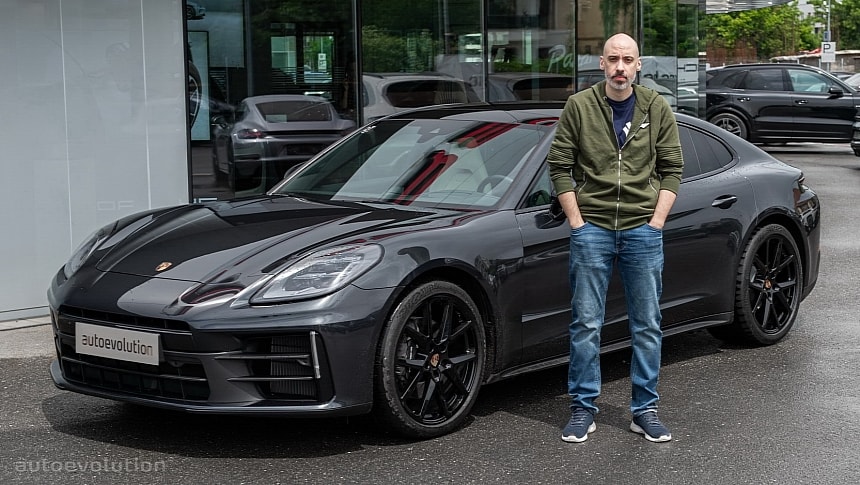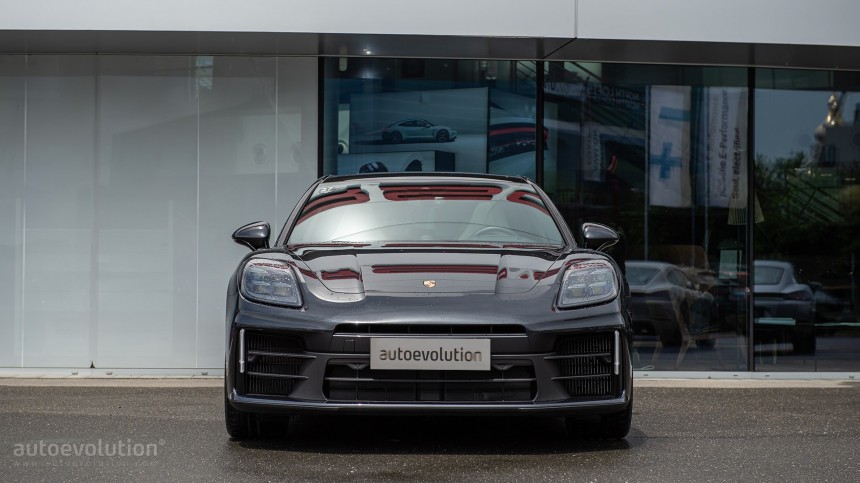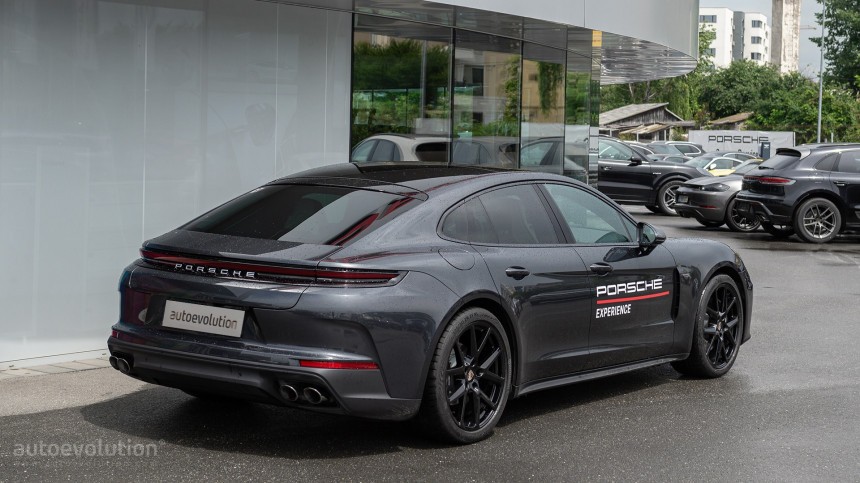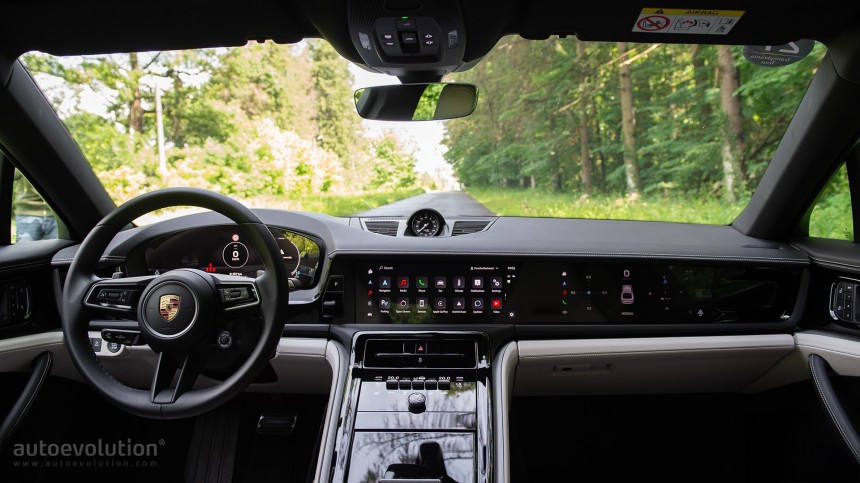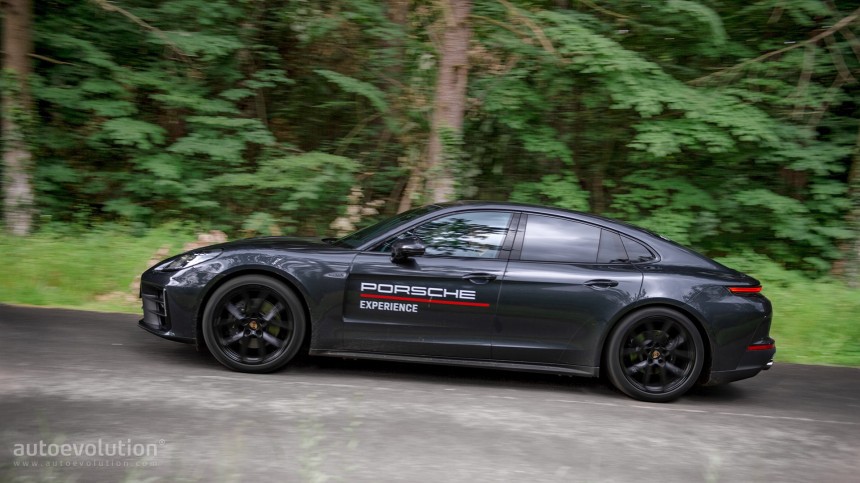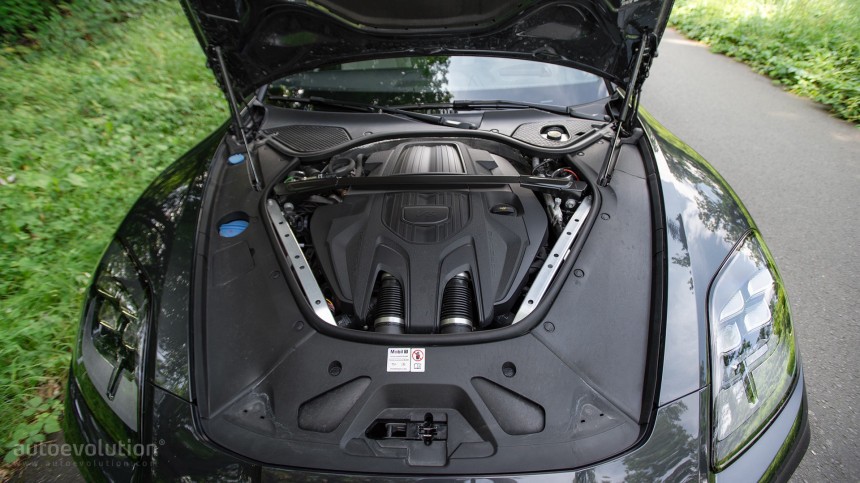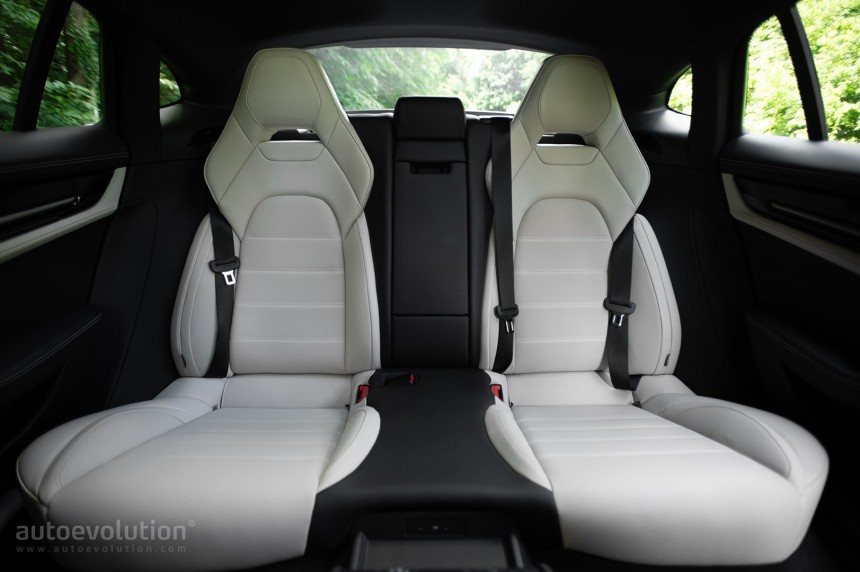Driven: 2025 Porsche Panamera 4 – This Sporty 4-Door Luxury Car Is a Total Apex Predator
Even though competitors from the likes of BMW, Mercedes-Benz and Audi exist, there’s still nothing else quite like the Porsche Panamera out there. It’s incredible to think that what was once a one-of-a-kind type of vehicle is still pretty much unmatched when it comes to the “overall package”.
People that have never driven a Panamera simply can’t know how weird of a product this is, and I mean that in a good way. It almost doesn’t make any sense, but thanks to Porsche’s mechanical wizardry, it all comes together to form what is undoubtedly the world’s best 4-door luxury sports car – now much improved in its third generation.
How is this any different from a Mercedes-AMG GT 4-door Coupe, Audi A7 or a BMW 8 Series Gran Coupe? My gosh, it couldn’t be more different. First of all, none of those cars feel as substantial as the Panamera, hence the term ‘luxury’. There’s always a sense of grandeur when driving this thing.
Tell you what, I’m going to describe the Porsche Panamera driving experience to you with a simple paragraph and some mental gymnastics. Here goes: Take something as wide as a Mercedes S-Class and flatten it so that you sit in it really low. Then, remove all the Mercedes suspension and steering bits, and replace them with Porsche components.
That’s pretty much it. A large luxury car that should otherwise have no business feeling as agile and as sharp as it does. It’s like a cheat code for the road, and it’s been that way ever since the first-gen car was unveiled back in 2009. More on that later.
Now, what we have here is the all-new, third-generation Panamera. Specifically, it’s the Panamera 4 variant, which means it’s a base-spec model but with all-wheel drive. Let me tell you a little bit about it.
Anyway, to say that the original Panamera’s design was controversial would be an understatement. People didn’t seem to mind the front-end styling that much, but once your eyes moved past the A-pillar, it was like the laws of physics started to break down. Some even went as far as to call it ‘ugly’, and it’s easy to understand why.
Taking the 911 recipe and adding two doors is by no means easy. Porsche also wanted to make sure the Panamera stood tall as a luxury car, which meant that they had to greatly increase the dimensions, compared to those of the 911. In other words, it wasn’t as easy as Aston Martin made it look with the Rapide – that thing was notoriously uncomfortable; especially for rear-seat passengers.
The facelift, which came out in 2013, didn’t do much to help. You still had to live with a fastback design that didn’t look as sharp as it needed to.
Then came the second-generation model in 2016 – longer, wider and taller than its predecessor. Here, Porsche fixed the often-criticized styling of the rear end by making a more direct connection to the 911 via that full-width LED light bar and a more aggressive overall design. They wanted to make the Panamera prettier, and they did achieve that. However, there’s a big difference between prettier and pretty, or dare we say even handsome. Porsche’s four-door luxury GT still had a ways to go.
Long story short, say 'hello' to the all-new, third-generation Panamera, perhaps the first-ever truly handsome four-door Porsche. This thing looks good right off the bat. The headlights are awesome, the front bumper is more aggressive, and the rear end is finally non-controversial. Mostly.
Personally, I love looking at it, and while I wouldn’t go as far as to say that 100% of its angles are worthy of being hung in the Louvre, the days of calling the Panamera ugly are clearly behind us.
Exterior highlights, as far as our test car was concerned, included the Volcano Grey Metallic colorway ($830 option), black trim accents, dark bronze exhaust outlets, Matrix LED headlights, gloss black 21-inch Panamera SportDesign wheels ($2,980 option plus $1,300 to have them painted black), and the soft-close doors, which I guess can be counted as both an exterior and interior highlight – it’s nice not having to slam them shut every time.
I would go as far as to say that 21” wheels suit the Panamera’s dimensions perfectly. You should absolutely stay away from the 19” standard wheels, while 20” makes for a decent compromise.
What is quite different, on the other hand, is the center console. Most of the physical buttons have been replaced by a touch panel. Meanwhile, a digital driver’s display replaces the older and more conventional gauges. Of course, there are three large displays (driver, central infotainment, passenger). Luckily, as the driver, you can’t really see what the passenger is doing on their display, so it can’t serve as a distraction.
In terms of specs, we’re dealing with Black/Kalahari Grey upholstery ($4,330 option), panoramic sunroof, Sport Chrono package (counts as an interior highlight too), 14-way power-adjustable front seats (also heated and ventilated), heated steering wheel, Silvershade trim accents, the previously-mentioned passenger display, a BOSE Surround Sound system, four-zone automatic climate control system, and a head-up display. I just have to say, I’m genuinely glad to see modern-day Porsche models featuring a head-up display after the carmaker resisted adopting this trend for so long. But that’s just a pet peeve of mine – I think HUDs are amazingly helpful.
Meanwhile, comfort-wise, the Panamera stars in its role. It doesn’t feel as roomy or plush as an S-Class, but then again it was never meant to. You still have plenty of space, both at the front and in the back (for two people), and the driving position is flawless in a car this size; although you’re constantly aware of the dimensions.
As for build quality, it feels similar to that of the second-gen Panamera. There’s little to nitpick here, but if I had to call out any negatives, I’d say that when sunlight/daylight hits that center console directly, you’re going to struggle to see the backlit climate control icons, which can be a little annoying. They should have angled the console slightly differently (like they did in the Taycan).
Lastly, let’s talk practicality. You’ve got room to charge your mobile phone wirelessly, you’ve got two giant cupholders, and a decent size trunk - 17.4 cu.ft (494 liters) of cargo volume, or 46.9 cu.ft (1,328 liters) with the seats folded down. Storage space within the door panels feels a bit tight, but that’s no dealbreaker.
Then there’s the adaptive dampers, which do a good job, but even at its most docile, the Panamera still feels rigid. This is good for spirited driving and aggressive cornering, but not so good when you’re just trying to forget about the outside world – which is something you can do in an S-Class or a 7 Series.
Then there’s the wind/road noise, which is slightly elevated by luxury car standards. This thing cuts through the air with the subtlety of a G-Wagen, and I suspect it’s because of that massive front fascia, coupled with the large wing mirrors and massive tires.
Now, before I talk about all the positives, let me remind you this is a base-spec Panamera 4 model, which means it’s powered by a twin-turbocharged 2.9-liter V6, good for 348 horsepower (353 ps) and 368 lb-ft (500 Nm) of torque. With a little help from the Sport Chrono package, it’ll get you to 60 mph (97 kph) in 4.5 seconds. This is easily the best V6 engine ever employed by Porsche. It makes this third-gen Panamera 4 feel like the first-gen Panamera Turbo.
It’s more than fast enough, and once you put it in Sport or Sport Plus, everything tightens up and you’re good to go. No car this size should have any business being this agile – yet Porsche pulls it off because that's what they do. I would go as far as to say that the whole drivetrain is a work of art, meaning the eight-speed automatic too.
When you launch it (using Launch Control), it feels as though you’re launching an Audi RS 4 rather than some large luxury sedan/fastback - and that’s a compliment. On paper, 348 hp and 368 lb-ft of torque doesn’t sound like much, especially in a car that weighs 2 tons, but again, that drivetrain setup is so good, the weight just fades into the background as you accelerate. Overall, the Panamera feels incredibly stable and planted at all speeds, which is exactly what you’d expect from this type of product.
Other performance figures include the 168-mph (270 kph) top speed, and the 13.3-second quarter mile time (with the Sport Chrono Package).
I would also say that while this is still a predominantly sporty car, it’s also more comfortable than both previous generations. Porsche did a good job with the adaptive dampers so as to improve ride quality. It could still be better, but probably at the expense of sharpness.
As for the engine note, the soundtrack is surprisingly delightful for a twin-turbo V6. Sounds throaty and vicious, particularly in Sport Plus mode.
What it is, however, is something very focused. You know exactly what you’re getting from it – power, prestige, and sports car-like characteristics. Of course, the Panamera only feels like a sports car when you open the tap and attack those sufficiently wide canyon roads, because in the city, it’s a totally different story.
Remember that flattened S-Class analogy I made earlier? That’s what this feels like when driving on narrower roads, except with even less visibility than you get in the S-Class. The front fender humps only add to the overall impression of width, as you might struggle to keep the car away from various curbs when maneuvering in tight spaces. Still, it’s nothing that you won’t be able to handle. If you want excellent visibility (and more practicality), you can easily opt instead for a Cayenne, which by the way isn’t as long, nor does it have as long a wheelbase as the Panamera.
Those of you that might care about fuel economy (most Panamera buyers won’t), would be interested to know that the average fuel consumption for the Panamera 4 is between 23.2 and 21 mpg (10.1 - 11.2 l/100 km), but that’s only if you’re driving Miss Daisy. In real world conditions, don’t expect to get anywhere near that.
Finally, we arrive at the price. The Panamera 4 kicks off from €120,809 stock, but our test car had quite a lot of optional extras, bringing the total to €149,377 – the equivalent of $161,000. Of course, if you live in the United States, you can purchase your brand-new 2024 Panamera 4 for a lot less. It’s got a starting MSRP of $109,800, but that’s before you add any extras. Speaking of which, make sure you tick the Rear Axle Steering option box ($1,350) when configuring your Panamera, otherwise you will most certainly regret it.
Bottom line, we still live in a world where Porsche doesn’t have to worry about the Panamera having any natural predators. It may not be perfect, but there’s really nothing else quite like it out there.
How is this any different from a Mercedes-AMG GT 4-door Coupe, Audi A7 or a BMW 8 Series Gran Coupe? My gosh, it couldn’t be more different. First of all, none of those cars feel as substantial as the Panamera, hence the term ‘luxury’. There’s always a sense of grandeur when driving this thing.
Tell you what, I’m going to describe the Porsche Panamera driving experience to you with a simple paragraph and some mental gymnastics. Here goes: Take something as wide as a Mercedes S-Class and flatten it so that you sit in it really low. Then, remove all the Mercedes suspension and steering bits, and replace them with Porsche components.
That’s pretty much it. A large luxury car that should otherwise have no business feeling as agile and as sharp as it does. It’s like a cheat code for the road, and it’s been that way ever since the first-gen car was unveiled back in 2009. More on that later.
Now, what we have here is the all-new, third-generation Panamera. Specifically, it’s the Panamera 4 variant, which means it’s a base-spec model but with all-wheel drive. Let me tell you a little bit about it.
Design Evaluation
It took 15 years for Porsche to perfect the styling of the Panamera, but it’s finally happened. The original Panamera, which debuted in 2009, was inspired by the Porsche 989 concept. It stood contrary to the carmaker’s typical lightweight two-door sports cars and supercars, although this wasn’t the first time that Porsche went against the grain. The Cayenne was their first major gamble and it paid off big time.Taking the 911 recipe and adding two doors is by no means easy. Porsche also wanted to make sure the Panamera stood tall as a luxury car, which meant that they had to greatly increase the dimensions, compared to those of the 911. In other words, it wasn’t as easy as Aston Martin made it look with the Rapide – that thing was notoriously uncomfortable; especially for rear-seat passengers.
The facelift, which came out in 2013, didn’t do much to help. You still had to live with a fastback design that didn’t look as sharp as it needed to.
Then came the second-generation model in 2016 – longer, wider and taller than its predecessor. Here, Porsche fixed the often-criticized styling of the rear end by making a more direct connection to the 911 via that full-width LED light bar and a more aggressive overall design. They wanted to make the Panamera prettier, and they did achieve that. However, there’s a big difference between prettier and pretty, or dare we say even handsome. Porsche’s four-door luxury GT still had a ways to go.
Long story short, say 'hello' to the all-new, third-generation Panamera, perhaps the first-ever truly handsome four-door Porsche. This thing looks good right off the bat. The headlights are awesome, the front bumper is more aggressive, and the rear end is finally non-controversial. Mostly.
Exterior highlights, as far as our test car was concerned, included the Volcano Grey Metallic colorway ($830 option), black trim accents, dark bronze exhaust outlets, Matrix LED headlights, gloss black 21-inch Panamera SportDesign wheels ($2,980 option plus $1,300 to have them painted black), and the soft-close doors, which I guess can be counted as both an exterior and interior highlight – it’s nice not having to slam them shut every time.
I would go as far as to say that 21” wheels suit the Panamera’s dimensions perfectly. You should absolutely stay away from the 19” standard wheels, while 20” makes for a decent compromise.
Interior Assessment
The dashboard design of the all-new Panamera is a lot like that of the second-generation car. It feels very familiar right off the bat. I’m talking about the upper dash, door panels, lower dash, and even the steering wheel – you need to look close to spot the differences.What is quite different, on the other hand, is the center console. Most of the physical buttons have been replaced by a touch panel. Meanwhile, a digital driver’s display replaces the older and more conventional gauges. Of course, there are three large displays (driver, central infotainment, passenger). Luckily, as the driver, you can’t really see what the passenger is doing on their display, so it can’t serve as a distraction.
In terms of specs, we’re dealing with Black/Kalahari Grey upholstery ($4,330 option), panoramic sunroof, Sport Chrono package (counts as an interior highlight too), 14-way power-adjustable front seats (also heated and ventilated), heated steering wheel, Silvershade trim accents, the previously-mentioned passenger display, a BOSE Surround Sound system, four-zone automatic climate control system, and a head-up display. I just have to say, I’m genuinely glad to see modern-day Porsche models featuring a head-up display after the carmaker resisted adopting this trend for so long. But that’s just a pet peeve of mine – I think HUDs are amazingly helpful.
As for build quality, it feels similar to that of the second-gen Panamera. There’s little to nitpick here, but if I had to call out any negatives, I’d say that when sunlight/daylight hits that center console directly, you’re going to struggle to see the backlit climate control icons, which can be a little annoying. They should have angled the console slightly differently (like they did in the Taycan).
Lastly, let’s talk practicality. You’ve got room to charge your mobile phone wirelessly, you’ve got two giant cupholders, and a decent size trunk - 17.4 cu.ft (494 liters) of cargo volume, or 46.9 cu.ft (1,328 liters) with the seats folded down. Storage space within the door panels feels a bit tight, but that’s no dealbreaker.
Driving Take
I’m going to start with a few negatives. The Panamera is a big car, and it absolutely needs rear-axle steering. Our tester didn’t have it and it showed. I also wish Porsche would work on some type of steer by wire system for this thing sometime in the future, because if there’s one car that could use it, it’s the Panamera. In other words, I’m not a fan of its turning circle. Feels like a chore by 2024 standards.Then there’s the adaptive dampers, which do a good job, but even at its most docile, the Panamera still feels rigid. This is good for spirited driving and aggressive cornering, but not so good when you’re just trying to forget about the outside world – which is something you can do in an S-Class or a 7 Series.
Now, before I talk about all the positives, let me remind you this is a base-spec Panamera 4 model, which means it’s powered by a twin-turbocharged 2.9-liter V6, good for 348 horsepower (353 ps) and 368 lb-ft (500 Nm) of torque. With a little help from the Sport Chrono package, it’ll get you to 60 mph (97 kph) in 4.5 seconds. This is easily the best V6 engine ever employed by Porsche. It makes this third-gen Panamera 4 feel like the first-gen Panamera Turbo.
It’s more than fast enough, and once you put it in Sport or Sport Plus, everything tightens up and you’re good to go. No car this size should have any business being this agile – yet Porsche pulls it off because that's what they do. I would go as far as to say that the whole drivetrain is a work of art, meaning the eight-speed automatic too.
When you launch it (using Launch Control), it feels as though you’re launching an Audi RS 4 rather than some large luxury sedan/fastback - and that’s a compliment. On paper, 348 hp and 368 lb-ft of torque doesn’t sound like much, especially in a car that weighs 2 tons, but again, that drivetrain setup is so good, the weight just fades into the background as you accelerate. Overall, the Panamera feels incredibly stable and planted at all speeds, which is exactly what you’d expect from this type of product.
I would also say that while this is still a predominantly sporty car, it’s also more comfortable than both previous generations. Porsche did a good job with the adaptive dampers so as to improve ride quality. It could still be better, but probably at the expense of sharpness.
As for the engine note, the soundtrack is surprisingly delightful for a twin-turbo V6. Sounds throaty and vicious, particularly in Sport Plus mode.
Everyday Living
What’s it like living with the Porsche Panamera? Well, I wouldn’t know, I don’t own one, but from the time I spent with it, I’m getting the sense that not all luxury car buyers would find the 2024 Panamera to be the perfect companion. Most people just want a luxury car that floats effortlessly on the road, and the Panamera ain’t that.What it is, however, is something very focused. You know exactly what you’re getting from it – power, prestige, and sports car-like characteristics. Of course, the Panamera only feels like a sports car when you open the tap and attack those sufficiently wide canyon roads, because in the city, it’s a totally different story.
Remember that flattened S-Class analogy I made earlier? That’s what this feels like when driving on narrower roads, except with even less visibility than you get in the S-Class. The front fender humps only add to the overall impression of width, as you might struggle to keep the car away from various curbs when maneuvering in tight spaces. Still, it’s nothing that you won’t be able to handle. If you want excellent visibility (and more practicality), you can easily opt instead for a Cayenne, which by the way isn’t as long, nor does it have as long a wheelbase as the Panamera.
Finally, we arrive at the price. The Panamera 4 kicks off from €120,809 stock, but our test car had quite a lot of optional extras, bringing the total to €149,377 – the equivalent of $161,000. Of course, if you live in the United States, you can purchase your brand-new 2024 Panamera 4 for a lot less. It’s got a starting MSRP of $109,800, but that’s before you add any extras. Speaking of which, make sure you tick the Rear Axle Steering option box ($1,350) when configuring your Panamera, otherwise you will most certainly regret it.
Test drive Round Up
The all-new 2024 Porsche Panamera is an exceptional machine. Even this entry-level variant. Just make sure you know exactly what you want from a luxury car before buying it over the equivalent S-Class or 7 Series – or the likes of the AMG GT 4-Door Coupe, for that matter. Now that I think about it, there’s only one other luxury car that comes close to offering you similar characteristics to the Panamera, and that’s the Maserati Quattroporte; but I don’t have to tell you which of the two is the superior product. You already know.Bottom line, we still live in a world where Porsche doesn’t have to worry about the Panamera having any natural predators. It may not be perfect, but there’s really nothing else quite like it out there.
Pros
- Driving dynamics
- Prestige
- Performance
- Tech
Cons
- Stiff suspension
- Road noise
About the author: Sergiu Tudose

Sergiu got to experience both American and European car "scenes" at an early age (his father drove a Ford Fiesta XR2 supermini in the 80s). After spending over 15 years at local and international auto publications, he's starting to appreciate comfort behind the wheel more than raw power and acceleration.
Full profile
